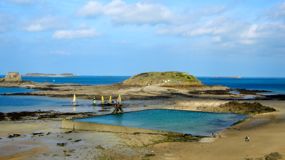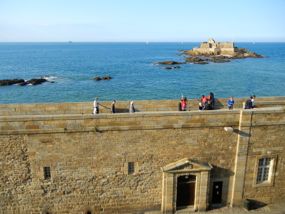 |
What to See in Saint-Malo, France | |
| The walled city, or "Intra-Muros," of Saint-Malo, and its beaches are the heart of this historic city in Brittany. | ||
|
|
|
Walking the RampartsSaint-Malo's ramparts, which date from the 12th to the 18th century, surround the entire old city. Walking the ramparts at any time of day is a popular pastime, particularly on sunny days. Gorgeous views across the water change with the tides and the sun, offering a never-ending natural show. Stairs at various points allow you to access the beach and the town, with its restaurants, shops, and squares. More... It's also fun to walk within the city itself. There are plenty of interesting buildings to see and lots of shopping opportunities. The Place due Marché aux Légumes, in the center of the walled city, is a great place to stop for a coffee or meal. Low-Tide WalksTwo walking excursions are possible only in the time around low tide. The Fort National, accessed from the walled town, is an easy walk across the sand and a short causeway. The island offers lovely views of St-Malo and the surrounding area. Guided tours of the Fort itself are available in the summer season; the timing of tours varies with the tides. More... It's important to pay careful attention to the tides, as the differences between high tide and low tide are dramatic. Check with the Tourist Information Office or your hotel for tide conditions. More... The Grand Bé and the Petit Bé, just off the coast, also offer beautiful views and are accessible at low tide. The tomb of French writer/diplomat François-René de Chateaubriand is on the Grand Bé. More... Saint-Malo BeachesSt-Malo is also known for its beaches, mostly to the east of the town. The beaches are wide (at low tide) and sandy and offer ample room for sunbathing. Many hotels and spas offer thalasso and spa packages. The main beach below the ramparts, the Plage Bon-Secours, includes an unusual "swimming pool." Partly enclosed, at high tide all you see is water, while at low tide the water is held in by the walls, which create a seaside swimming pool. This allows for swimming without having to walk way out to reach the water. It even has a diving board. The Castle (Château)The St-Malo Castle dates from the 14th and 15th centuries and today houses St-Malo's History Museum. In addition to the castle itself, with its keeps and towers, the museum is home to about 8000 artifacts. Exhibits range from underwater archaeology to tapestries to fishing and life in the St-Malo region. St-Malo was at its peak in the 17th and 18th centuries, one of three main French ports (along with LeHavre and Marseille), and was active in shipbuilding and trade, also featured in the museum. And at the top, you can access an outer walkway and enjoy views of the town and the islands. Cathédrale of St-VincentThe Cathédrale of St-Vincent, located Intra-Muros, dates from the 12th to the 18th centuries. Like much of St-Malo, it suffered during World War II, but its beautiful stained glass windows remain. It houses the tombs of Jacques Cartier and famous corsair (privateer) René Duguay-Trouin. Cartier, a favorite son of St-Malo, is remembered fondly. Here knelt Jacques Cartier to receive the benediction of the Bishop of St-Malo, at his departure for the discovery of Canada, 16 May 1535. Wandering in Saint-MaloThere is much to see and do in St-Malo, and most of it is in the small area within the old city walls. It's a beautiful spot to spend a few days enjoying history, the sea air, gorgeous views, interesting walks, and fine food. Don't forget to enjoy some of the Breton specialties, including seafood, cider, and delicious pastries!
|
|
Above, Bon-secours pool, with Petit Bé and Grand Bé in the background, St-Malo.
|




